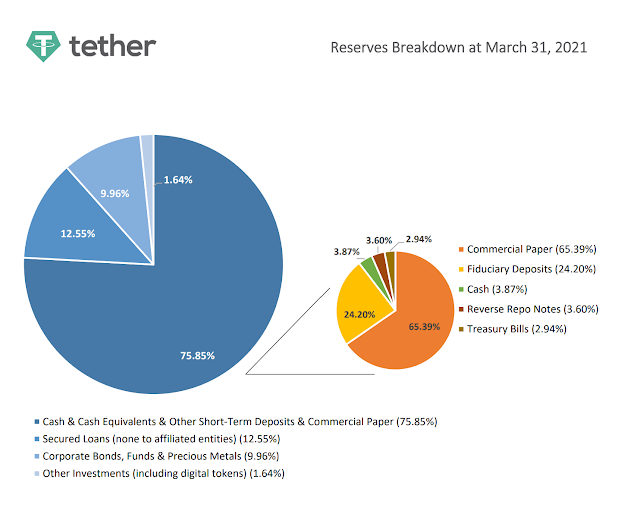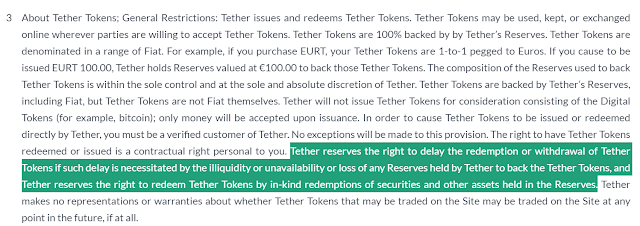Seriously, this is all Tether has seen fit to reveal. Furthermore, the pie charts only purport to show the breakdown of Tether’s reserves on the 31st March 2021. We do not know whether Tether’s reserves still have the same composition now.
Nonetheless, the crypto world took these charts as an indication that Tether was, if not fully cash-backed, at least mostly. “76% of its reserves are in cash or cash equivalents, whereas banks only have 10%!”, crowed several people.
In both the reserve report and the
monthly attestation, Tether takes “reserves” to mean total consolidated assets. The monthly attestations from Moore Cayman essentially say:
1. Tether’s total consolidated assets exceed its consolidated liabilities
2. Tether’s total consolidated liabilities exceed the quantity of tokens in issue
3. Therefore Tether’s reserves exceed the quantity of tokens in issue
Following this logic, “reserves” must equal total consolidated assets.
If a bank produced an attestation like this as proof of reserve adequacy it would be marked zero out of ten and sent back to redo its homework. For a bank, “reserves” are narrowly defined as deposits at the central bank and vaulted currency. Unless it is a full-reserve bank – and these are rare breeds which tend not to live very long – reserves are some distance short of total consolidated assets, even in these days of QE-driven excess reserves.
Clearly, if we want to compare Tether to banks, we need to use the same definition of reserves. But Tether doesn’t have central bank deposits or vaulted currency. What would be the equivalent for Tether?
To work this out, we need to understand why banks have reserves. Contrary to popular mythology, they have nothing to do with lending. Banks don’t lend out reserves. Reserves are the money that banks use to make payments. When your employer pays your wages into your bank account, your employer’s bank pays your bank an amount of reserves equal to your wages. When you pay your rent, your bank pays out an equal amount of reserves to your landlord’s bank. When you withdraw cash from an ATM, your bank loses an equal amount of reserves: when you pay cash in to the bank, your bank gains an equal quantity of reserves.
Reserve requirements for regulated banks ensure that the illiquid and risky part of bank balance sheets doesn’t become so large that the bank’s ability to make payments is compromised. That was the purpose of the Fed’s iconic 10% reserve requirement, beloved of “money multiplier” aficionados. However, reserve requirements are now effectively obsolete: they have been superseded by the Basel committee’s “liquidity coverage ratio” and additional local regulation such as the Fed’s “living wills”, QE has forced banks to hold far more reserves than notional reserve requirements, and intraday central bank overdrafts ensure that banks can always obtain reserves to settle payments. The Fed abolished the 10% reserve requirement in March 2020.
If a bank doesn’t have access to a central bank – for example if it is an unregulated “
shadow bank” - then it must either keep enough actual cash on its books to settle all payments, or it must hold sufficient high-quality liquid assets to be able to obtain the cash it needs to settle all payments. If an unregulated bank doesn’t have enough cash on its books and is unable to get any more, it can’t make payments or allow depositors to withdraw money. In these days of electronic payments, “cash” does not necessarily mean physical currency. It is much more likely to mean money in insured deposit accounts at another bank. Shadow banks are the customers of regulated banks.
Assets held for the purposes of obtaining cash at need must be highly liquid and stable in value: an asset that is illiquid or prone to sudden swings in value can’t be relied on to provide the cash needed to make payments. So, Treasury bills and, for US markets, agency MBS are regarded as safe liquid assets equivalent to reserves. Junk bonds are not. But in between these two extremes is a huge morass of bonds and commercial paper that might or might not be realisable in cash terms at need without catastrophic loss of value. So unless we know what the composition of an unregulated bank’s liquid assets are, we can’t be sure it can meet payment requests.
And this is why comparing Tether to a regulated bank is wrong. If Tether is a bank at all, it is an unregulated shadow bank. It does not have access to central bank liquidity and it has no deposit insurance. So its “reserves” must include sufficient high-quality liquid assets to ensure that it can always obtain the cash needed to make payments.
Normally, a stablecoin issuer should not have to make much in the way of payments. If people want to sell their stablecoin holdings, they can do so through exchanges. Only if people tried to redeem their stablecoins directly with Tether – for example, if exchanges suspended trading in the stablecoins - would Tether potentially have to make payments. So, Tether needs to hold sufficient safe liquid assets to ensure that it can meet redemption requests in the event of exchanges suspending trading. This need not mean holding much actual cash, but it would mean holding substantial quantities of safe liquid assets.
However, this clause in
Tether’s terms of service says that if Tether was unable to raise the cash to redeem stablecoins, it would either delay redemption or offer something other than actual fiat currency:
It’s worth remembering that in 2016, Tether’s sister exchange Bitfinex
partially seized USD deposits to make good its losses from a hack, and gave depositors a new coin it had just invented instead. Tether’s terms of service appear to give it the legal right to do the same in the event of redemption requests that it can’t satisfy with fiat currency.
Given this, there appears to be no particular reason for Tether to hold much in the way of safe liquid assets.
The reserve statement shows that Tether’s asset base consists largely of commercial paper, fiduciary deposits and corporate debt. Tether’s General Counsel, Stuart Hoegner,
insists that these are mostly investment grade, but there is no independent verification of his statement and he unfortunately was complicit in previous statements of Tether’s reserves that
turned out to be fiction. But if Tether is simply going to refuse redemption requests or offer people tokens it has just invented instead of fiat currency, it wouldn’t matter if the entire asset base was junk, since it will never have any significant need for cash.
So whether Tether’s "reserves" are cash equivalents doesn't matter. But what does matter is capital.
For banks, funds and other financial institutions, capital is the difference between assets and liabilities. It is the cushion that can absorb losses from asset price falls, whether because of fire sales to raise cash for redemption requests or simply from adverse market movements or creditor defaults.
The accountant's attestations reveal that Tether has very little capital. The gap between assets and liabilities is paper-thin: on 31st March 2021 (pdf), for example, it was 0.36% of total consolidated assets, on a balance sheet of more than $40bn in size. Stablecoin holders are thus seriously exposed to the risk that asset values will fall sufficiently for the par peg to USD to break – what money market funds call “breaking the buck”.
The money market fund Reserve Primary MMF
broke the buck in 2008 due to significant losses from its holdings of Lehman paper. Its net asset value (NAV) only fell to 97 cents, but that was enough to trigger a rush for the exit. Reserve Primary became insolvent and was eventually wound up.
Asset price falls could similarly result in Tether “breaking the buck”. But unlike Reserve Primary, stablecoin holders wouldn’t be able to get their money out if asset values fell. They would either have to try to sell their stablecoins on exchanges or sit tight and hope that asset values recovered. And this is why the composition of Tether’s asset base matters. All the noise about “reserves” entirely misses the point. It’s the risk of asset price falls that is the real problem for holders of Tether stablecoins, not lack of cash for redemptions.
Tether’s asset base consists almost entirely of assets that are exposed to the risk of default, illiquidity and sudden price falls. We don’t know how serious this risk is, but it’s reasonable to assume that the worse the rating of the assets, the greater the likelihood that the par peg will break. As the whole point of a stablecoin is the par peg, “breaking the buck” would be a massive deal for Tether. It might not render it insolvent, but it would make it pointless.
It wouldn't even be necessary for asset prices actually to fall for the par peg to break. If punters thought Tether’s assets were significantly exposed to losses, the stablecoins would trade at a discount to par sufficient to compensate stablecoin holders for the risk of not getting all their money back. The higher the risk, the deeper the discount.
So when Tether sceptics cast doubt on the soundness of Tether’s debt assets, particularly its commercial paper, they put pressure on the par peg. And if Tether could not effectively counter their allegations, the peg would break – permanently.
It’s hardly surprising therefore that Tether’s General Counsel has now
stated publicly that Tether’s commercial paper and fiduciary deposits are “mostly” at least A2 rated.
But the mystery is why Tether is so reluctant to publish full details of its asset composition. Surely, the best way to prevent the par peg breaking is to provide solid evidence that the asset base is safe and liquid? An unsupported assertion from a lawyer with a tarnished reputation is hardly reassuring. Why don't they simply reveal their asset composition? And why are they running with so little capital?
Smoke and mirrors may maintain the peg for a while, but people won’t be fooled forever. If Tether is serious about delivering “unrivalled transparency”, it should publish the composition of its assets in sufficient detail to eliminate all doubts about their safety and liquidity. And if it wants the par peg to hold under all circumstances, it must significantly increase its capital. If it won’t do either of these, then eventually the mirror will crack, the peg will break and Tether will be doomed.
Related reading:



